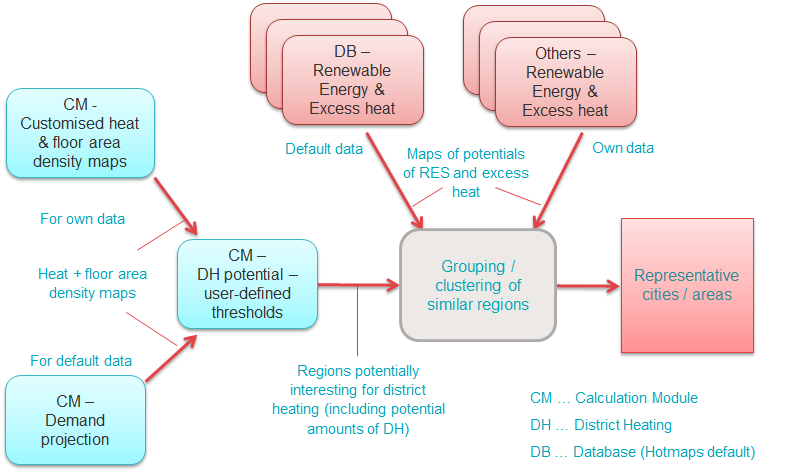

not logged in | [Login]
Disclaimer: The explanation provided on this website (Hotmaps Wiki) are indicative and for research purposes only. No responsibility is taken for the accuracy of the provided information, explanations and figures or for using them for unintended purposes.
Data privacy: By clicking OK below, you accept that this website may use cookies.
Scenario Toolchain Steps
Next step
This is the first step of the analysis at national level.
In order to identify different, representative, typical cases for further analysis of the costs and potentials for district heating in the country/region of interest Hotmaps provides various default data layers in the Hotmaps database as well as different Calculation Modules (CMs). Also, own data can be uploaded and used. This identification procedure can consist of the following steps:
The following figure shows this procedure graphically and shows the various data sources and calculation modules that can be used.
 Figure: Identification of different representative, typical cases for district heating (Step 1)
Figure: Identification of different representative, typical cases for district heating (Step 1)
In the following subchapters, the different steps in this procedure are described in more detail.
The first step in the analysis is to generate future heat demand and gross floor area density maps for your region/country of interest. You can use data developed in the course of the Hotmaps project for all EU-28 countries (Hotmaps default data, available in the Hotmaps database), or you can use other heat demand density maps for your region/country of interest.
The developed heat demand and gross floor area density maps are further used in the subsequent steps in other Calculation Modules (CMs).
After developing possible future scenarios of heat demand and gross floor area density maps for the city/area of interest, potential district heating cities/areas can be identified. This can be done using the CM - District heating potential areas: user-defined thresholds according to the following steps:
In this step, the potentials for excess heat and renewable energy in the regions that have been identified as potentially interesting for district heating can be analysed. These data together with the data on heat demand and heat demand density in the regions collected in the previous step can then be used to characterise representative district heating areas for further analysis steps. The following list gives an overview of the heat sources that should be taken into account and links to the default data for the respective energy source, which is available in the Hotmaps database:
The data collected in the two previous steps can be used to define different types of representative, typical district heating (DH) areas in the region/country of interest. Regions/cities with similar dimensions and combinations of total heat demand, average heat demand density, and potentials for renewable energy and excess heat can be grouped.
Possible indicators for grouping of typical district heating areas:
For each of the developed groups of typical DH areas, then one or several representative cities/regions can be selected and further analysed. These can serve as representative case studies.
Marcus Hummel, Giulia Conforto, in Hotmaps-Wiki, Guidelines for using the Hotmaps toolbox for analyses at national level (August 2020)
This page was written by Marcus Hummel and Giulia Conforto e-think.
☑ This page was reviewed by Mostafa Fallahnejad EEG - TU Wien.
Copyright © 2016-2020: Marcus Hummel, Giulia Conforto
Creative Commons Attribution 4.0 International License
This work is licensed under a Creative Commons CC BY 4.0 International License.
SPDX-License-Identifier: CC-BY-4.0
License-Text: https://spdx.org/licenses/CC-BY-4.0.html
We would like to convey our deepest appreciation to the Horizon 2020 Hotmaps Project (Grant Agreement number 723677), which provided the funding to carry out the present investigation.
View in another language:
Bulgarian* Czech* Danish* German* Greek* Spanish* Estonian* Finnish* French* Irish* Croatian* Hungarian* Italian* Lithuanian* Latvian* Maltese* Dutch* Polish* Portuguese (Portugal, Brazil)* Romanian* Slovak* Slovenian* Swedish*
* machine translated
Last edited by web, 2020-09-30 11:29:36